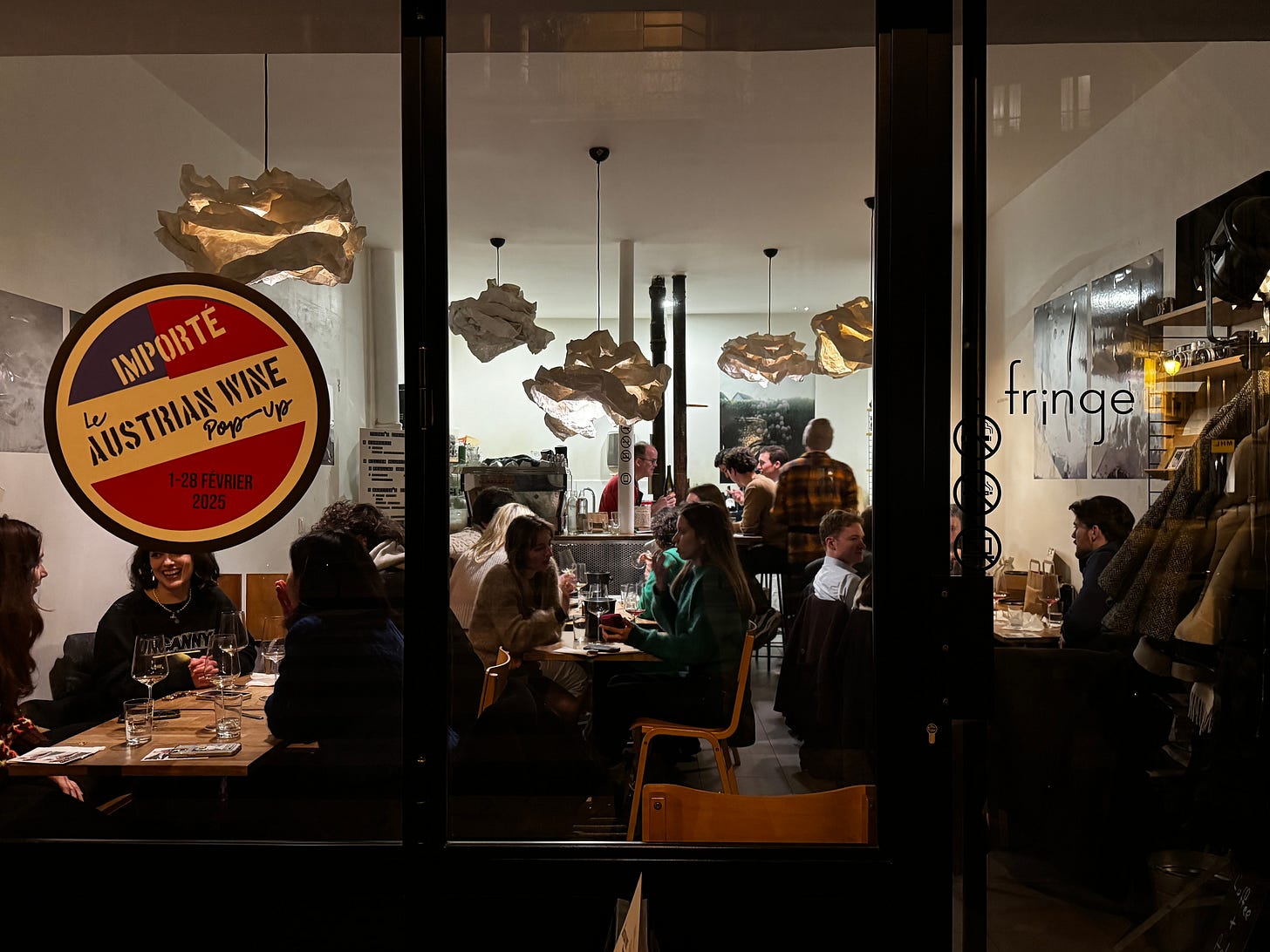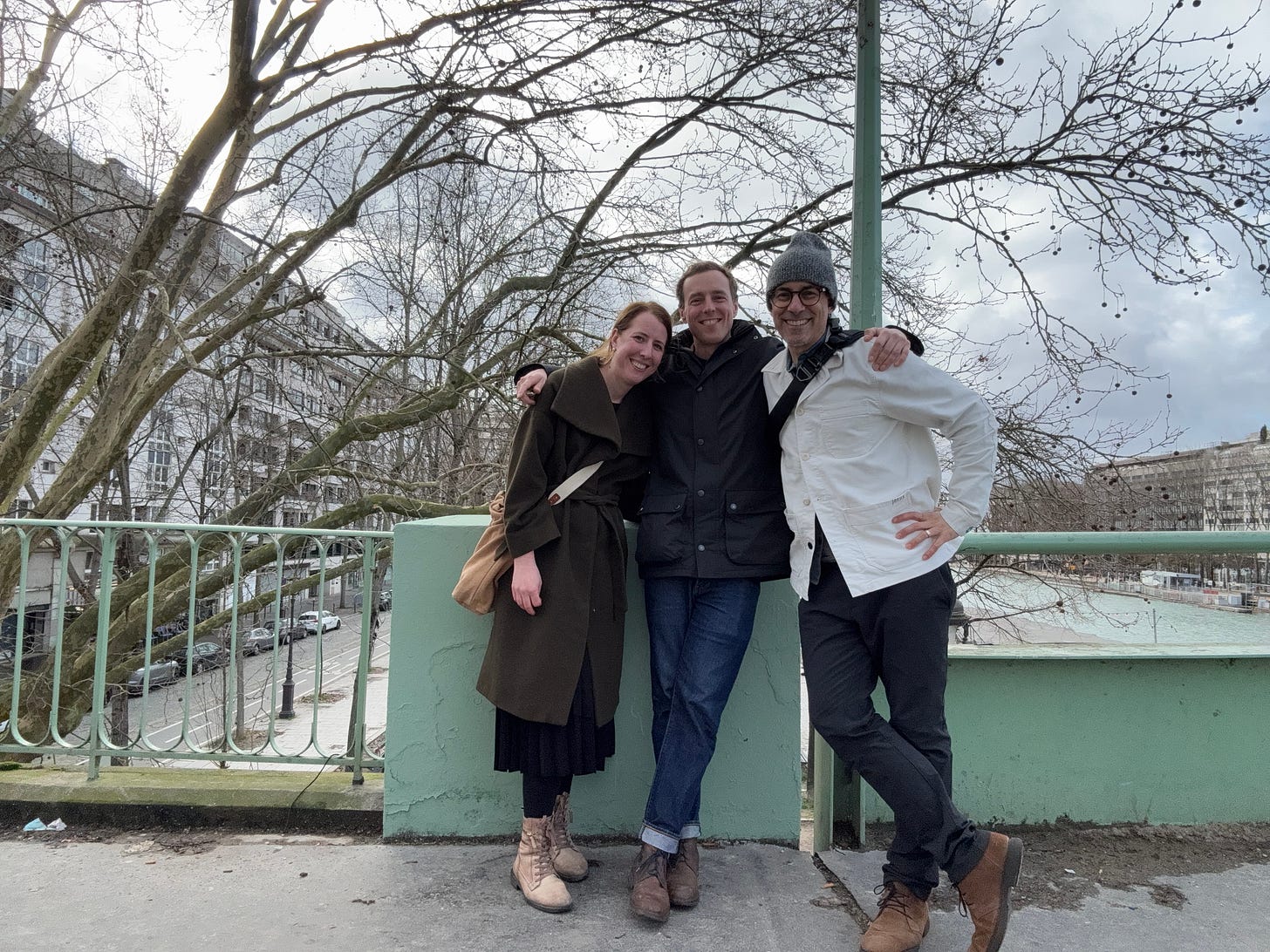What We Learned After Hosting a Pop-Up Wine Bar in Paris for a Month
What happens when two young, boutique wineries from Austria host a pop-up wine bar in Paris for 28 days with 500 bottles of wine?
As told by Chris Sciacca with contributions from Donica Kelloway and Robert Bormuth
“Every year, European consortiums spend millions on agricultural promotional subsidies that go to trick out flashy new wineries, pay for wine swag and host junkets. I’ve seen the waste. Without pointing a finger, I’ll say that the money is not always well spent. Why not spend more of those funds to get good wine into the hands of young drinkers at reasonable prices in major urban areas? In other words, subsidize wine programs and restaurant-based events that greatly reduce by-the-glass prices. We need at least one Italian Wine Week, French Wine Week, Spanish Wine Week, Sonoma Wine Week, Tuscan Wine Week, Rhône Wine Week, Champagne, Crémant or Whatever Wine Week every week of the year!”, Robert Camuto, prize-winning American author and journalist wrote in Wine Spectator on 7 January 2025.
Little did Mr. Camuto know at the time of his article that a plan was already in place to host an Austrian pop-up wine bar in Paris, but our plan had a few amendments. For instance, our “wine week” would be a wine month from 1-28 February, open every day from 18:00 until midnight. And wine professionals and students can taste as much as they want for free and consumers pay only 10 EUR for the night — bread and cheese included.
A Pop-Up Grows in Paris
With an eye on bottling and selling my first vintage, my wife and I travelled to Paris in May of 2023 and what I saw was disheartening. After the twenty-fifth shop the same four to five Austrian wineries were on every wine bar menu and shop shelf. Kudos to the wineries and their importer, but what does this mean for the rest of us?
Upon further investigation, and according to statistics from the Austrian Wine Marketing Board, the share of Austrian wine exported to France is 0.85 percent. France, the second leading consumer of wine in the world isn’t even in the top 10 and there are only three importers focused on Austrian wine for France. How could a small start-up winery tap the Parisian market with so many headwinds? Merde!
A bit rattled I found myself in Paris’s Le Marais district having a coffee at Fringe, a nine-year old specialty coffee shop. I found the metaphor of Fringe´s greyish-white, storm cloud ceiling lamps hovering above me dripping in irony — but then a bolt of lightening. What about a pop-up wine bar to introduce Austrian wines to the Parisian market?
The idea sat with me until we returned home to Vienna and a few days later I met with Robert Bormuth and Uli Filp. Two PhD scientists, turned winemakers, who launched Weingut Feldtheorie, a year before my own project. I shared my pop-up idea and they were excited to participate. In fact, Robert would join me for the month. Word quickly spread and the momentum carried us to 40 additional wineries from the main winemaking regions of Lower Austria, Vienna, Burgenland and Styria.
As luck would have it, the owner of Fringe was a fan of natural wines and since he closed every evening the coffee shop was available for rent — he also had a license to serve wine and a 200-year old cellar below that we could use to store everything. It was kismet.
Now I needed some wine. The pitch to the wineries was simple. If you are interested in the Parisian market, donate two cases of wine, and we will pour them and tell your story to everyone who will listen. No risk and no additional costs. In fact, if you want to travel to Paris and work at the pop-up you can even crash at our AirBnB for a few days at no cost. I made the same offer to friends and family who agreed to work with us and many of them accepted, including Donica Kelloway, a masters student at L'Ecole supérieure des agricultures. With some financial and marketing support from the Austrian Wine Marketing Board the Le Austrian Wine Pop-Up was ready.
28 Days Later
In summary, the pop-up was a hit. Every Saturday we featured 12-16 wines (click for menus) spanning sparkling, white, orange, rose and red. Surprisingly, most guests wanted the full tasting menu, spending on average 90 minutes, which indicated they wanted to learn and experience Austrian wine, not just consume it.
After 28 days we hosted 518 (Chart 1) guests including several chefs, importers from the Netherlands, Singapore and Korea, wine shop and bar owners, sommeliers, journalists, social influencers, wine club members and WSET students getting ready to take their level three exam.

Demographically, our guests were more women and I would say nearly everyone was between 25-45 years old. One big takeaway, very few, if anyone, knew about Austrian wine and even less about our local varieties, Grüner Veltliner, Zweigelt and Blaufrankish. The upside is everyone loved the wines. Low intervention wines were a big hit, along with sparkling Pétillant Naturel (Pet Nat) and orange wines, which many were tasting for the first time. We also offered some non-alcohol sparkling tea and zero percent alcohol Grüner Veltliner, which was appreciated by a handful of people who were extending their dry January a few more weeks.
Many guests were also unfamiliar with biodynamic and hybrid fungus and mildew resistant grapes, which reminded us that we have to get out of our wine-jargon bubble when explaining wine.
But to answer the question, “what did the three of us learn?”, for starters as an industry, we have to get out of our own way. We made drinking wine enjoyable and not pretentious. We greeted people when they arrived, jokingly saying, “we are serving Austrian wine, not Australian, so no kangaroos.” We explained our own unique journeys to the wine industry and we then guided our guests through the menu taking questions without so much as a snicker if someone didn’t know that orange wine doesn’t contain oranges.
And we told the stories of the wineries and the winemakers sharing anecdotes along the way, such as the 18th generation winemakers at Vitikultur Moser or Charly Rol, the Frenchman from Burgundy who is making wine in Austria after falling in love with a local.
If our guests wanted to go deeper into the winemaking process or the regions, we answered their questions and even had maps and handbooks with further details. But what we didn’t do was make them feel intimidated.
The pop-up also worked in-part because we came to our guests and we didn’t make them come to us. By hosting the event in a coffee shop, located in a trendy neighborhood, they were in a familiar space, instead of a fairground 60 minutes outside of the city centre.
So Mr. Camuto, I hope you agree, this is “a win-win wine proposal” that any region can do.
If anyone would like more details on how the pop-up was organised just ask.









We don't do enough of this in the US and we should. I "take-over" some of my closest retailers shops for a night or two, but I'd be happy to pour all week at a venue. We have festivals, which don't do much other than overwhelm people with brands and marketing. Doing it small, partnering with retailers and restaurants is how I like to do it. Cool model in Paris.
Excellent account of a successful event, Chris. I particularly liked the demographic breakdown and the “time spent” element, very interesting. Your comment about banishing the pretentiousness and just “get out of the way” rings very true. This is a model for others planning a similar event and definitely one to build on. Congratulations!